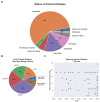Neurodevelopment and early pharmacological interventions in Fragile X Syndrome
- PMID: 37599992
- PMCID: PMC10433175
- DOI: 10.3389/fnins.2023.1213410
Neurodevelopment and early pharmacological interventions in Fragile X Syndrome
Abstract
Fragile X Syndrome (FXS) is a neurodevelopmental disorder and the leading monogenic cause of autism and intellectual disability. For years, several efforts have been made to develop an effective therapeutic approach to phenotypically rescue patients from the disorder, with some even advancing to late phases of clinical trials. Unfortunately, none of these attempts have completely succeeded, bringing urgency to further expand and refocus research on FXS therapeutics. FXS arises at early stages of postnatal development due to the mutation and transcriptional silencing of the Fragile X Messenger Ribonucleoprotein 1 gene (FMR1) and consequent loss of the Fragile X Messenger Ribonucleoprotein (FMRP) expression. Importantly, FMRP expression is critical for the normal adult nervous system function, particularly during specific windows of embryogenic and early postnatal development. Cellular proliferation, migration, morphology, axonal guidance, synapse formation, and in general, neuronal network establishment and maturation are abnormally regulated in FXS, underlying the cognitive and behavioral phenotypes of the disorder. In this review, we highlight the relevance of therapeutically intervening during critical time points of development, such as early postnatal periods in infants and young children and discuss past and current clinical trials in FXS and their potential to specifically target those periods. We also discuss potential benefits, limitations, and disadvantages of these pharmacological tools based on preclinical and clinical research.
Keywords: Fragile X syndrome; GABA; PI3K; clinical trials; mGluR; neurodevelopment; pharmacological interventions.
Copyright © 2023 Milla, Corral, Rivera, Zuñiga, Pino, Nunez-Parra and Cea-Del Rio.
Conflict of interest statement
The authors declare that the research was conducted in the absence of any commercial or financial relationships that could be construed as a potential conflict of interest.
Figures


References
-
- Altable M., de la Serna J. M. (2021). Neuroinflammation links COVID-19 and fragile X syndrome: role of MMP-9, IGF-1, IL-10, metformin, statins and curcumin. Qeios. doi: 10.32388/KO4C77.2 - DOI
-
- Bailey D. B., Berry-Kravis E., Wheeler A., Raspa M., Merrien F., Ricart J., et al. . (2015). Mavoglurant in adolescents with fragile X syndrome: analysis of clinical global impression-improvement source data from a double-blind therapeutic study followed by an open-label, long-term extension study. J. Neurodev. Disord. 8, 1–10. doi: 10.1186/s11689-015-9134-5 - DOI - PMC - PubMed
Publication types
Associated data
LinkOut - more resources
Full Text Sources
Miscellaneous

